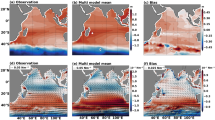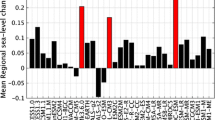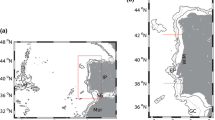Abstract
Global atmosphere-ocean general circulation models are the tool by which projections for climate changes due to radiative forcing scenarios have been produced. Further, regional atmospheric downscaling of the global models may be applied in order to evaluate the details in, e.g., temperature and precipitation patterns. Similarly, detailed regional information is needed in order to assess the implications of future climate change for the marine ecosystems. However, regional results for climate change in the ocean are sparse. We present the results for the circulation and hydrography of the Barents Sea from the ocean component of two global models and from a corresponding pair of regional model configurations. The global models used are the GISS AOM and the NCAR CCSM3. The ROMS ocean model is used for the regional downscaling of these results (ROMS-G and ROMS-N configurations, respectively). This investigation was undertaken in order to shed light on two questions that are essential in the context of regional ocean projections: (1) How should a regional model be set up in order to take advantage of the results from global projections; (2) What limits to quality in the results of regional models are imposed by the quality of global models? We approached the first question by initializing the ocean model in the control simulation by a realistic ocean analysis and specifying air-sea fluxes according to the results from the global models. For the projection simulation, the global models’ oceanic anomalies from their control simulation results were added upon initialization. Regarding the second question, the present set of simulations includes regional downscalings of the present-day climate as well as projected climate change. Thus, we study separately how downscaling changes the results in the control climate case, and how scenario results are changed. For the present-day climate, we find that downscaling reduces the differences in the Barents Sea between the original global models. Furthermore, the downscaled results are closer to observations. On the other hand, the downscaled results from the scenario simulations are significantly different: while the heat transport into the Barents Sea and the salinity distribution change modestly from control to scenario with ROMS-G, in ROMS-N the heat transport is much larger in the scenario simulation, and the water masses become much less saline. The lack of robustness in the results from the scenario simulations leads us to conclude that the results for the regional oceanic response to changes in the radiative forcing depend on the choice of AOGCM and is not settled. Consequently, the effect of climate change on the marine ecosystem of the Barents Sea is anything but certain.












Similar content being viewed by others
References
Ådlandsvik B (2008) Marine downscaling of a future climate scenario for the North Sea. Tellus 60A: 451–458. http://dx.doi.org/10.1111/j.1600-0870.2008.00311.x
Årthun M, Schrum C (2010) Ocean surface heat flux variability in the Barents Sea 83(83): 88–98. http://dx.doi.org/10.1016/j.jmarsys.2010.07.003
Årthun M, Ingvaldsen RB, Smedsrud LH, Schrum C (2011) Dense water formation and circulation in the Barents Sea 58: 801–817. http://dx.doi.org/10.1016/j.dsr.2011.06.001
Årthun M, Eldevik T, Smedsrud LH, Skagseth Ø, Ingvaldsen R (2012). Quantifying the influence of Atlantic heat on Barents Sea ice variability and retreat 25: 4736–4743
Arzel O, Fichefet T, Goosse H (2006) Sea ice evolution over the 20th and 21st centuries as simulated by current AOGCMs 12: 401–415. http://dx.doi.org/10.1016/j.ocemod.2005.08.002
Bentsen M, Drange H (2000) Parameterizing surface fluxes in ocean models using the NCEP/NCAR reanalysis data. Regclim General Technical Report 4, Norwegian Institute for Air Research, Kjeller, Norway
Berliand M, Berliand T (1952) Determining the net long-wave radiation of the earth with consideration of the effect of cloudiness. Isv Akad Nauk SSSR Ser Geofis (1)
Blindheim J, Loeng H (1981) On the variability of Atlantic influence in the Norwegian and Barents Seas. Fisk dir Skr Ser Havunders 17: 161–189
Carton J A, Chepurin G, Cao X (2000a) A simple ocean data assimilation analysis of the global upper ocean 1950–95. Part II: Results 30: 311–326
Carton J A, Chepurin G, Cao X, Giese B (2000b) A simple ocean data assimilation analysis of the global upper ocean 1950-95. Part I: Methodology 30: 294–309
Collins W D, Bitz C M, Blackmon M L, Bonan G B, Bretherton C S, Carton J A, Chang P, Doney S C, Hack J J, Henderson T B, Kiehl J T, Large W G, McKenna D S, Santer B D, Smith R D (2006) The community climate system model version 3 (CCSM3) 19: 2112–2143
Doscher R, Willen U, Jones C, Rutgersson A, Meier H E M, Hansson U, Graham L P (2002) The development of the regional coupled ocean-atmosphere model RCAO. Boreal Environ Res 7: 183–192. http://dx.doi.org/10.1088/1748-9326/7/3/034005
Drinkwater K, Mueter F, Friedland K, Taylor M, Hunt G L, Hare J, Melle W (2009) Recent climate forcing and physical oceanographic changes in Northern Hemisphere regions: a review and comparison of four marine ecosystems 73: 190–202. http://dx.doi.org/10.1016/j.pocean.2007.02.002
Fairall CW, Bradley EF, Hare JE, Grachev AA, Edson JB (2003) Bulk parameterization of air-sea fluxes: Updates and verification for the COARE algorithm 16: 571–591
Ferry N, Reverdin G (2004) Sea surface salinity interannual variability in the western tropical Atlantic: an ocean general circulation model study 109(C05026)
Gammelsrød, Leikvin Ø, Lien V, Budgell WP, Loeng H, Maslowski W (2009) Mass and heat transports in the NE Barents Sea: Observations and models 75: 56–69. http://dx.doi.org/10.1016/j.jmarsys.2008.07.010
Gill AE (1982) Atmosphere–ocean dynamics. Academic, London
Häkkinen S, Cavalieri D J (1989) A study of the oceanic heat fluxes in the Greenland. Norwegian and Barents Seas 95(C5): 6145– 6157
Harms IH, Schrum C, Hatten K (2005) Numerical sensitivity studies on the variability of climate-relevant processes in the Barents Sea 110(C06002)
Helland-Hansen B, Nansen F (1909) Report on Norwegian fish and marine investigations. In the Norwegian Sea, vol. 2
Holt J, Wakelin S, Lowe J, Tinker J (2010) The potential impacts of climate change on the hydrography of the northwest European continental shelf 86: 361–379. http://dx.doi.org/10.1016/j.pocean.2010.05.003
Ingvaldsen R B, Loeng H, Asplin L (2002) Variability in the Atlantic inflow to the Barents Sea based on a one-year time series from moored current meters 22: 505–519
Ingvaldsen R B, Asplin L, Loeng H (2004) Velocity field of the western entrance to the Barents Sea 109(C03021): 1–12. http://dx.doi.org/10.1029/2003JC001811
IPCC (2007) Climate Change 2007: The Physical Science Basis. In: Solomon S., Qin D., Manning M., Chen Z., Marquis M., Averyt K. B., Tignor M., Miller H. L. (eds) Contribution of working group I to the fourth assessment report of the intergovernmental panel on climate change. Cambridge University Press, Cambridge, pp 747–847
Large W G, Yeager S G (2009) The global climatology of an interannually varying airsea flux data set 33: 341–364. http://dx.doi.org/10.1007/s00382-008-0441-3
Lien V S, Gusdal Y, Albretsen J, Melsom A, Vikebø F (2013) Evaluation of a Nordic Seas 4 km numerical ocean model hindcast archive (SVIM), 1960-2011. Fisken og Havet 7
Loeng H (1991) Features of the physical oceanographic conditions of the Barents Sea. In: Sakshaug CCEH E, Britsland N A (eds) Proceedings of the pro mare symposium on polar marine ecology, pp 5–18
Loeng H, Drinkwater K (2007) An overview of the ecosystems of the Barents and Norwegian seas and their response to climate variability 54: 2478–2500
Marchesiello P, McWilliams J C, Shchepetkin A (2001) Open boundary conditions for long-term integration of regional oceanic models 3: 1–20
Meier H E M, Andersson H C, Arheimer B, Blenckner T, Chubarenko B, Donnelly C, Eilola K, Gustafsson B G, Hansson A, Havenhand J, Hoglund A, Kuznetsov I, MacKenzie B R, Muller-Karulis B, Neumann T, Niiranen S, Piwowarczyk J, Raudsepp U, Reckermann M, Ruoho-Airola T, Savchuk O P, Schenk F, Schimanke S, Vali G, Weslawski J M, Zorita E (2012) Comparing reconstructed past variations and future projections of the Baltic Sea ecosystem-first results from multi-model ensemble simulations. Environ Res Lett (034005): 8. http://dx.doi.org/10.1088/1748-9326/7/3/034005
Melsom A, Lien V S, Budgell W P (2009) Using the Regional Ocean Modeling System (ROMS) to improve the ocean circulation from a GCM 20th century simulation 59: 969–981. http://dx.doi.org/10.1007/s10236-009-0222-5
Overland J E, Wang M (2007) Future regional Arctic sea ice declines 34(L17705): 1–7. doi: 10.1029/2007GL030808
Parkinson CL, Vinnikov KY, Cavalieri DJ (2006) Evaluation of the simulation of annual cycle of Arctic and Antarctic sea ice coverages by 11 major global climate models 111(C07012)
Sætra Ø, Hersbach H, Bidlot JR, Richardson DS (2004) Effects of observation errors on the statistics for ensemble spread and reliability. Mon Weather Rev 132: 1487–1501
Sandø AB, Nilsen JEØ, Gao Y, Lohmann K (2010) The importance of heat transports and local air-sea heat fluxes for the Barents Sea climate variability. J Geoph Res 115(C07013). doi:10.1029/2009JC005884
Sandø AB, Gao Y, Langehaug HR (2014) Poleward ocean heat transports, sea ice processes, and Arctic sea ice variability in NorESM1-M simulations. J Geoph Res 119(3): 2095–2108. http://dx.doi.org/10.1002/2013JC009435
Schlesinger M E, Ramankutty N (1994). An oscillation in the global climate system of period 65-70 years 367: 723– 726
Shchepetkin AF, McWilliams JC (2005) The regional oceanic modeling system (ROMS): a split-explicit, free-surface, topography-following-coordinate oceanic model 9:347–404
Shchepetkin A F, McWilliams J C (2008) Quasi-monotone advection schemes based on explicit locally adaptive dissipation 126: 1541–1580
Simonsen K, Haugan P M (1996). Heat budgets of the Arctic Mediterranean and sea surface flux parameterizations of the Nordic Seas 101(C3): 6553–6576
Skagseth Ø, Drinkwater KF, Terrile E (2011) Wind-induced transport of the Norwegian Coastal Current in the Barents Sea 116(C08007): 1–15. http://dx.doi.org/10.1029/2011JC006996
Smagorinsky J (1963) General circulation experiments with the primitive equations 91: 99–164
Smedsrud L H, Ingvaldsen R, Nilsen JEØ, Skagseth Ø (2010) Heat in the Barents Sea: Transport, storage, and surface fluxes 6: 219–234. URL www.ocean-sci.net/6/219/2010/
Smith S D C W F, Geemaert G L, Hasse L (1996) Air-sea fluxes: 25 years of progress. Boundary Layer Meteor 78: 247–290
Song Y, Haidvogel D (1994) A semi-implicit ocean circulation model using a generalized topography-following coordinate system. J Comput Phys 115: 228–244
Vinje T, Kvambekk ÅS (1991) Barents Sea drift ice characteristics 10(1): 59–68. http://dx.doi.org/10.1111/j.1751-8369.1991.tb00635.x
Acknowledgments
This work was supported by the Norwegian Research Council projects NorClim and EarthClim, the Centre for Climate Dynamics at the Bjerknes Centre, and by the Norwegian Supercomputer Committee through a grant of computing time.
Author information
Authors and Affiliations
Corresponding author
Additional information
Responsible Editor: Jin-Song von Storch
Appendix
Appendix
The equations in this appendix are provided by Bentsen and Drange (2000). Bulk expressions relating turbulent fluxes of momentum and heat to measurable atmospheric variables (Smith et al. 1996)
where ρ a is the air density; C D , C H , and C E are the transfer coefficients for momentum, sensible heat, and latent heat, respectively; S is the average wind speed; u is the mean wind vector; Θ is the potential temperature; and q is the specific humidity, all measured at the reference height z r . T s and q s are the temperature and specific humidity at sea surface, respectively.
If the turbulent fluxes of momentum, heat, and sea surface state are available from reanalysis or an atmosphere circulation model, the corresponding near surface atmospheric state can be estimated. This atmospheric state together with the sea surface state from the model is used to estimate the final fluxes to be applied. An iterative scheme is used to calculate the atmospheric state at height z r , and first guesses must be made for the transfer coefficients, the gustiness, w G , and air density. In the following, the subscript n denotes the iteration number, d denotes data from reanalysis or atmospheric model, and m denotes ocean model.
The mean wind speed vector u n at z r is solved from the bulk expression:
and is given by
The average wind speed \(S=\sqrt {u^{2}+{w_{G}^{2}}}\) at z r is updated as
Thereafter, the potential temperature and specific humidity at z r are solved from the bulk expressions \(Q_{H,d}=\rho ^{n-1}_{a}c_{pa}C^{n-1}_{H,d}S^{n}(T_{s,d}-\Theta ^{n})\) and
\(Q_{L,d}=\rho ^{n-1}_{a}L_{e}C^{n-1}_{E,d}S^{n}(q_{s,d}-q^{n})\), respectively, and result in
The air density are finally updated by a standard equation of state for moist air (Gill 1982)
where p s,d is the surface pressure from the data. A new set of transfer coefficients C D,m ,C H,m ,a n d C E,m and gustiness, w G,m , are computed with the atmospheric state, consistent with the sea surface state represented by T s,m and q s,m . Using Eqs. 1–3, the turbulent fluxes to be used by the ocean model are:
For parameterization of net long-wave radiation at the sea surface, Q l,m , the approach by Berliand and Berliand (1952) is used
where ε is the emissivity of water, σ is the Stefann-Boltzmann constant, e is the water vapor pressure, and (1−χ C 2) is a cloud correction term. The air temperature at z r =10 m is related to the estimated potential temperature as
To get consistent heat fluxes, the net long-wave radiation supplied by the reanalysis or atmospheric model, Q l,d , is used
By subtracting Eq. 15 from Eq. 13, the following expression for net long-wave radiation results
Rights and permissions
About this article
Cite this article
Sandø, A.B., Melsom, A. & Budgell, W.P. Downscaling IPCC control run and future scenario with focus on the Barents Sea. Ocean Dynamics 64, 927–949 (2014). https://doi.org/10.1007/s10236-014-0731-8
Received:
Accepted:
Published:
Issue Date:
DOI: https://doi.org/10.1007/s10236-014-0731-8




